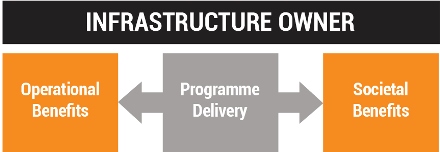Programme management techniques can be used to help communicate the tangible benefits of public infrastructure projects says Paul Taylor.
Major UK capital infrastructure investments are at a scale not seen for half a century, providing considerable stimulus for local economic development. Programme management techniques are essential in the delivery of public infrastructure and must help to maximise the societal outcomes to businesses, customers, and the wider communities they serve.
It is the responsibility of those promoting and managing these programmes to ensure that the tangible benefits are being effectively communicated to local communities and other stakeholders.
Upskilling the UK workforce and creating local jobs
Local employment opportunities during infrastructure projects can be a major contributor to the way an organisation is perceived within a community. Understanding the potential employment opportunities within the programme and how they can be channelled to local suppliers is crucial.
In this strategic stage, it is vital to map the skill requirements in design, manufacture and construction for delivering the programme to set the overall capability requirements of the supply chain. Confidence in continuing resource capability is critical for both the infrastructure owner and its supply chain. A joint approach to talent development, through the inclusion of training investment requirements within the contract, is most effective.
Programme management teams need to understand the education and training institutions being used by the infrastructure owner and supply chain. As infrastructure programmes may be several years in length, this understanding enables effective long-term planning. Using resource projections, the programme management team can assess the demand for skills for which the local education institutions will need to cater for.
A project’s programme management team therefore must, as a minimum:
- Map the level of employment requirements created by the infrastructure programme.
- Identify the key skillsets needed for the programme.
- Understand the local resource availability, highlighting shortfalls.
- Structuring the programme to accommodate training and development on a mid- to long-term.
- Define a balance of workload between client and the supply chain including SMEs.
Boosting reinvestment of infrastructure incomes into local economies

Infrastructure investment encourages further reinvestment into communities. Better infrastructure draws in new and different businesses, creating more jobs and opportunities, boosting the local economy still further.
The infrastructure owner is best placed to enable these multiple and interlinked benefits through:
- Ensuring support for supply chain resilience to bring in other investment into the community.
- Understanding infrastructure spend within infrastructure owners’ geographical footprint.
- Engaging in local planning and development.
- Enabling circular re-investment into economy.
- Minimising transportation of goods and services to control environmental impact.
Two key measures are needed to understand the tangible financial re-investment that the infrastructure owner makes in its operating area. The first is the outline geographical B2B expenditure in its supply chain, to map the overall investment into local businesses. The second is the level of circular reinvestment stimulated, to see how B2B transactions convert to B2C transactions in each location.
Converting programme revenue to societal value

Re-investment into local economies and communities should be clearly visible and measurable. Communicating the ‘societal dividend’ created by infrastructure investment is critical in engaging stakeholders.
In taking social responsibility, the infrastructure owner needs to shape its supply chain to work collectively with local communities to maximise the socio-economic benefits. There are five principles that underpin this mission:
- The infrastructure owner, employees, customers and supply chain must have similar aspirations to support the communities where they live and work, including a realisation of mutual opportunities.
- Identify the ‘societal dividend’ of resolving the issues most relevant to the community in which the infrastructure owner operates, where both the infrastructure owner and the community can benefit.
- Plan the ‘societal dividend’ when delivering infrastructure by developing approaches that provide interim benefits during the investment period.
- Communicate the societal dividend with regulators, shareholders, employees, supply chain, customers and consumers about how the delivery programme is encouraging sustainable investment for the benefit of all.
- Measure and monetise the societal dividend using Social Return on Investment techniques to show the programme’s achievements for the communities
The key is for industry is to enhance its communications approach. It must be about more than simply justifying potential disruptions. It must go further, ensuring engagement with harder to reach audiences to broaden the awareness of the wider societal value that programmes of investment can bring.
Paul Taylor is technical director, programme management at Stantec.

